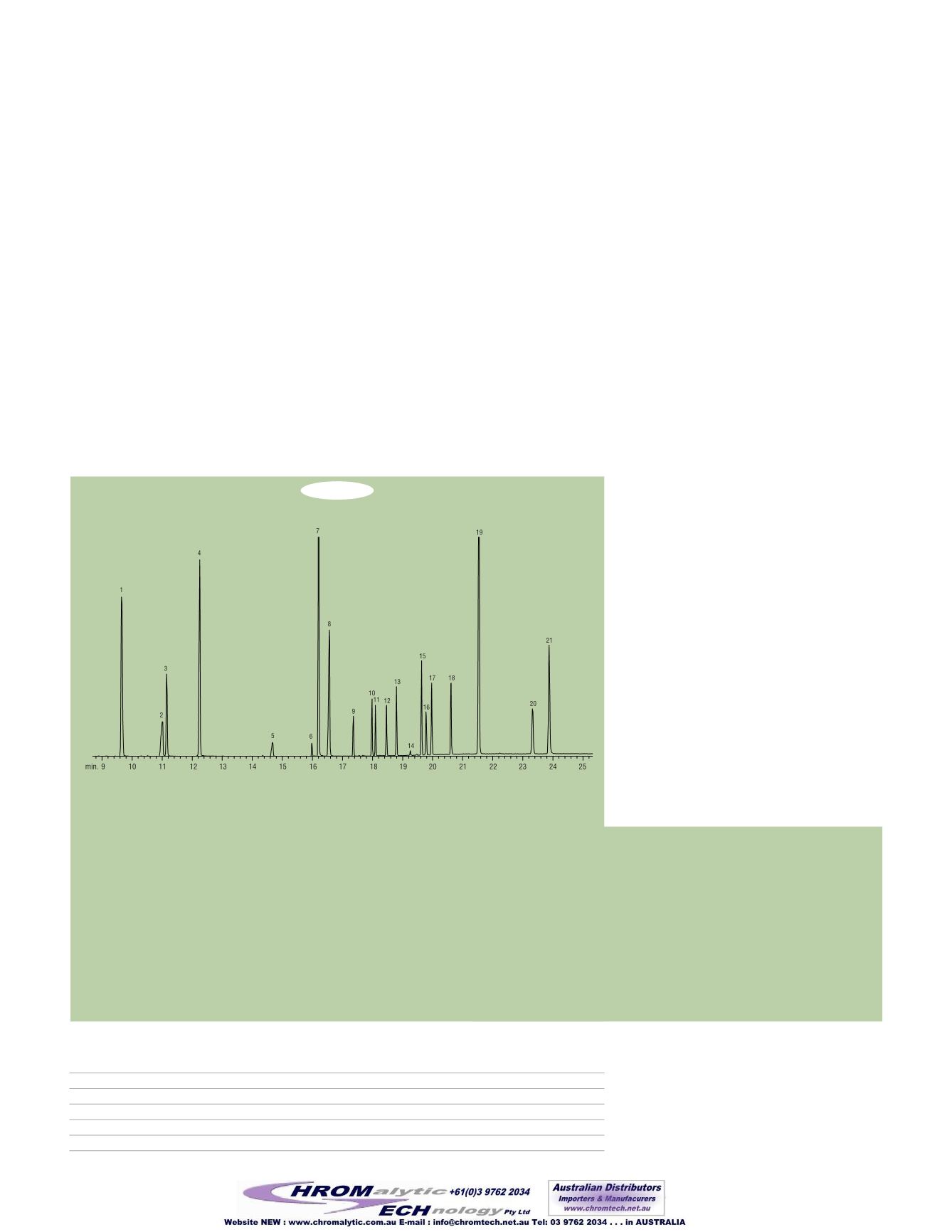

• 7 •
www.restekcorp.com800-356-1688
by Christopher English, Environmental Innovations Chemist
Analysis of European
Organophosphorus Pesticides
Fast, Complete Resolution Using an
Rtx
®
-CLPesticides Column
✔
Fastest analysis of 21 target OPPs and surrogates.
✔
Extremely low column bleed at temperatures >300ºC.
✔
Use Rtx
®
-CLPesticides columns with FPDs, NPDs, or GC/MS systems.
Our European customers provided us with a list of
organophosphorus compounds and asked us to help
develop a GC analysis. Restek offers the analytical
reference standards, and we now have determined
the chromatography column and conditions needed
for a problem-free analysis of these materials.
Organophosphorus pesticide (OPP) is a general term
that includes all phosphorus-containing insecticides.
Because these compounds eliminate target insects
effectively, then break down into non-toxic derivatives,
they have replaced many of the environmentally per-
sistent organochlorine pesticides. By 1959 over
50,000 different OPPs had been prepared. OPPs are
hydrolyzed by bases and acids and are photosensitive,
which makes them ideal for agricultural applications.
The main concern OPPs pose is the intact mole-
cules’ high toxicity to mammals—these chemicals
are considered the most toxic of all pesticides to
vertebrates. Further, at low levels, OPPs can be
endocrine-disrupting compounds (EDC) - materials
that interfere with hormone activities in mammals.
Dimethoate and malathion have been shown to be
in this category. Consequently, dimethoate and
malathion are on the European Priority List; further
study is required to determine if use of these two
pesticides should be suspended.
We used computer modeling software to design the
Rtx
®
-CLPesticides column for analyses of chlorinat-
ed pesticides, but this column also is well suited for
analyses of electronegative species, such as OPPs.
We evaluated many columns for resolving this
selection of compounds, and we found that the
Rtx
®
-CLPesticides column resolves these com-
pounds to baseline in the least amount of time.
The 30m x 0.25mm x 0.25µm Rtx
®
-CLPesticides col-
umn configuration is best suited for GC/MS applica-
tions; a 30m x 0.32mm x 0.50µm column can be
used with direct injections and FPD or NPD detec-
tion. The GC/MS analysis is shown in Figure 1. For
the application shown we added the surrogates most
commonly used with FPD or NPD detectors and
optimized conditions so that all compounds, includ-
ing the four added surrogates, are baseline resolved.
The high temperature stability of Rtx
®
-CLPesticides
columns enabled us to bring the oven temperature
to 330°C, following each analysis, to bake out high
molecular weight contaminants commonly found in
OPP-containing extracts. The ability to condition
these columns at higher temperatures, not attain-
able with commonly used cyano phases, will enable
you to make more injections with an
Rtx
®
-CLPesticides column.
In most laboratories, fast, efficient sample through-
put is important. In analyses of organophosphorus
pesticides, an Rtx
®
-CLPesticides column is an
important part of attaining—and maintaining—this
goal.
Rtx
®
-CLPesticides columns are available in
convenient and economical kits
that include a deactivated guard column and
a connector. Refer to our general catalog, or
contact your local Restek representative.
Figure 1
An Rtx
®
-CLPesticides column provides sharp, fast resolution of organophosphorus pesticides.
Ordering Information
| Rtx
®
-CLPesticides Columns (Fused Silica)
ID
df (µm)
temp. limits
10-Meter
15-Meter
20-Meter
30-Meter
60-Meter
0.10mm 0.10 -60 to 310/330°C 43101
0.18mm 0.18 -60 to 310/330°C 42101
42102
0.25mm 0.25 -60 to 320/340°C
11120
11123
11126
0.32mm 0.50 -60 to 320/340°C
11136
11139
0.53mm 0.50 -60 to 300/320°C
11137
11140
GC_EV00648
Column:
Rtx
®
-CLPesticides, 30m, 0.25mm ID, 0.25µm (cat.# 11123)
Sample:
Custom European Standard Mix
call for details
1-bromo-2-nitrobenzene
cat.# 32279
4-chloro-3-nitrobenzotrifluoride
cat.# 32282
tributylphosphate
cat.# 32280
triphenylphosphate
cat.# 32281
Inj.:
1.0µL splitless (hold 0.4 min.)
4mm double gooseneck inlet liner (cat.# 20785)
Inj. temp.:
250°C
Carrier gas:
helium, constant flow, 6 psi head pressure
Flow rate:
0.75mL/min.
Linear velocity:
28cm/sec.
Dead time:
1.82 min. @ 80°C
Oven temp.:
80°C (hold 1.0 min.) to 150°C @ 7°C/min. (no
hold) to 280°C @ 15°C/min. (hold 7 min.)
Det.:
Agilent 5971A GC/MS
Transfer line temp.:
280°C
Scan range:
35–400 amu
Solvent Delay:
5 min.
Tuning compound:
PFTBA
Ionization:
EI
Compound
Conc. on-column (ng)*
1. 4-chloro-3-nitrobenzotrifluoride (surr.) 100
2. methamidophos
50
3. dichlorvos
50
4. 1-bromo-2-nitrobenzene (surr.)
100
5. acephate
20
6. demeton-S-methyl
20
7. tributylphosphate (surr.)
100
8. omethoate
100
9. dimethoate
20
10. tolclofos-methyl
10
11. pirimiphos methyl
10
Compound
Conc. on-column (ng)*
12. chlorpyrifos
10
13. malathion
20
14. quinalphos
10
15. tokuthion (prothiofos)
20
16. methidathion
20
17. profenfos
20
18. ethion
20
19. triphenylphosphate (surr.)
100
20. azinphos-methyl
40
21. pyrazophos
50
*This mix was prepared for FPD analyses. Peaks will be approximately equivalent in height with FPD
detection (0.32mm ID column).


















